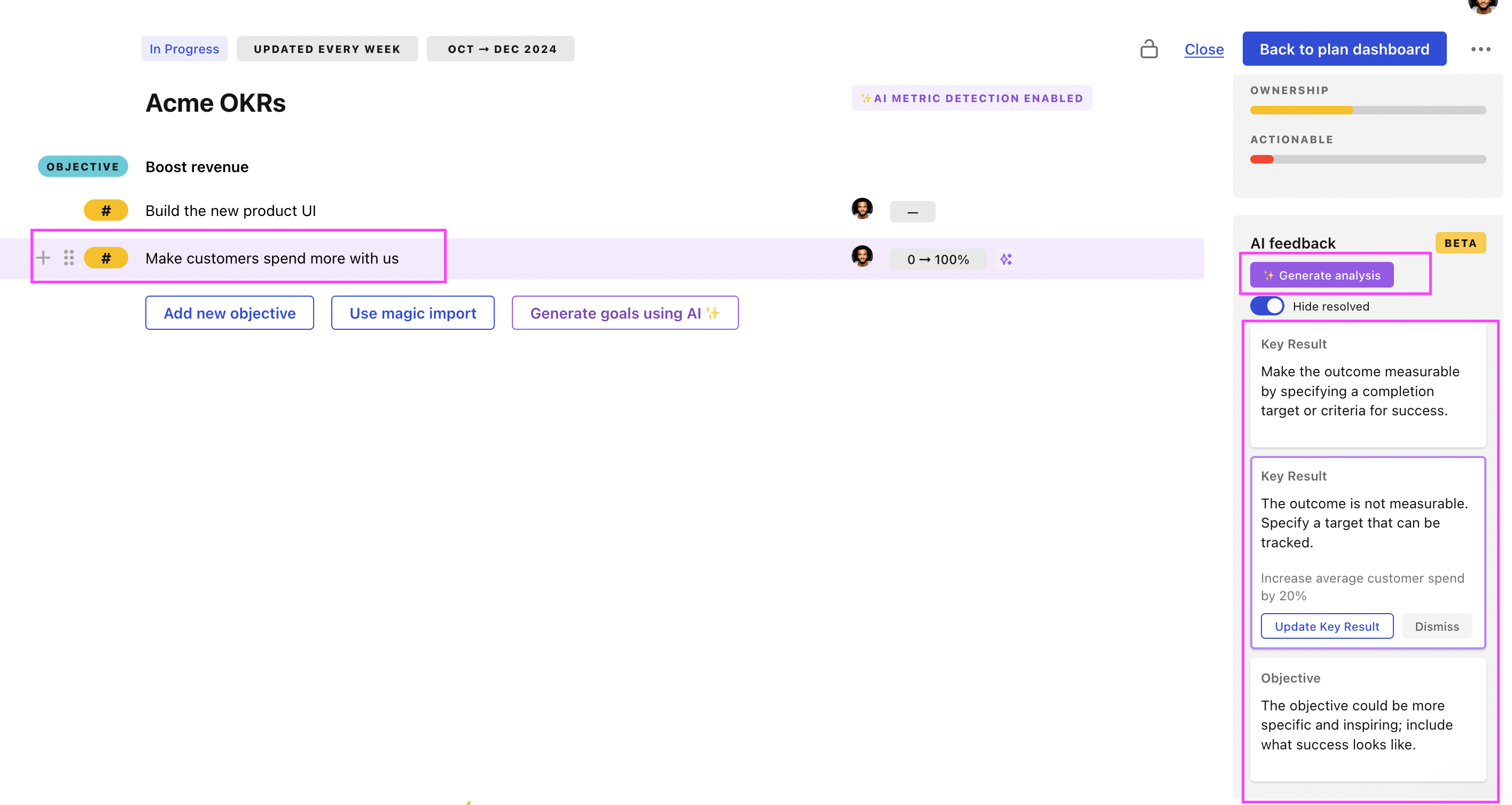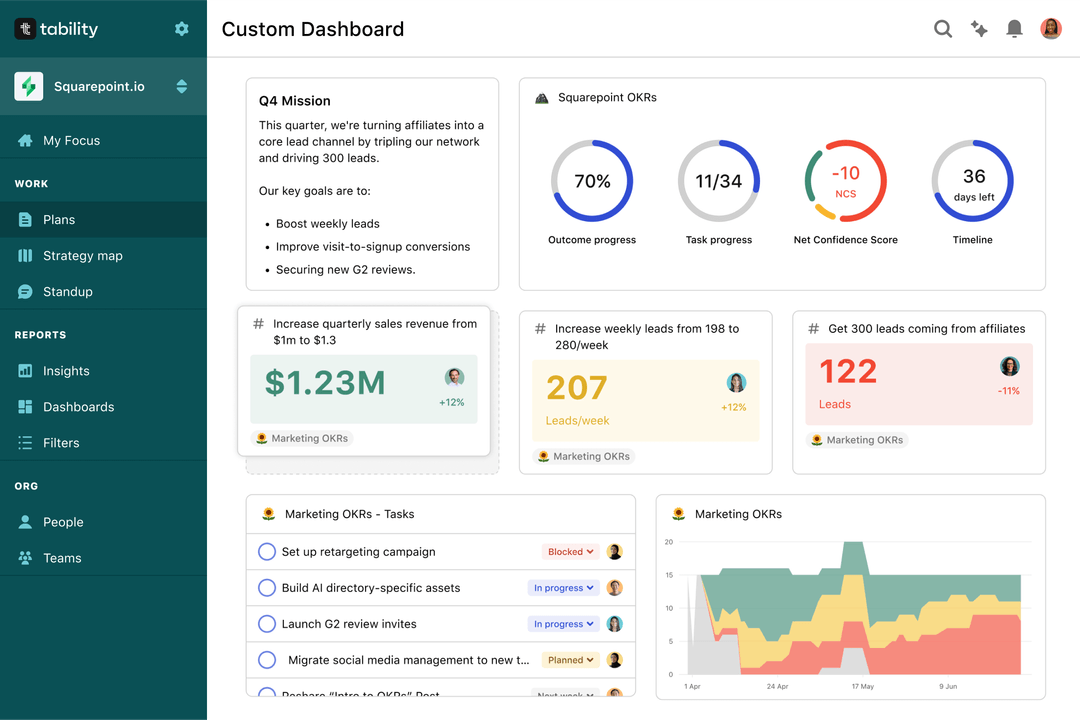Tability is a cheatcode for goal-driven teams. Set perfect OKRs with AI, stay focused on the work that matters.
What are Maintenance Costs OKRs?
The Objective and Key Results (OKR) framework is a simple goal-setting methodology that was introduced at Intel by Andy Grove in the 70s. It became popular after John Doerr introduced it to Google in the 90s, and it's now used by teams of all sizes to set and track ambitious goals at scale.
How you write your OKRs can make a huge difference on the impact that your team will have at the end of the quarter. But, it's not always easy to write a quarterly plan that focuses on outcomes instead of projects.
That's why we have created a list of OKRs examples for Maintenance Costs to help. You can use any of the templates below as a starting point to write your own goals.
If you want to learn more about the framework, you can read our OKR guide online.
The best tools for writing perfect Maintenance Costs OKRs
Here are 2 tools that can help you draft your OKRs in no time.
Tability AI: to generate OKRs based on a prompt
Tability AI allows you to describe your goals in a prompt, and generate a fully editable OKR template in seconds.
- 1. Create a Tability account
- 2. Click on the Generate goals using AI
- 3. Describe your goals in a prompt
- 4. Get your fully editable OKR template
- 5. Publish to start tracking progress and get automated OKR dashboards
Watch the video below to see it in action 👇
Tability Feedback: to improve existing OKRs
You can use Tability's AI feedback to improve your OKRs if you already have existing goals.
- 1. Create your Tability account
- 2. Add your existing OKRs (you can import them from a spreadsheet)
- 3. Click on Generate analysis
- 4. Review the suggestions and decide to accept or dismiss them
- 5. Publish to start tracking progress and get automated OKR dashboards

Tability will scan your OKRs and offer different suggestions to improve them. This can range from a small rewrite of a statement to make it clearer to a complete rewrite of the entire OKR.
Maintenance Costs OKRs examples
You will find in the next section many different Maintenance Costs Objectives and Key Results. We've included strategic initiatives in our templates to give you a better idea of the different between the key results (how we measure progress), and the initiatives (what we do to achieve the results).
Hope you'll find this helpful!
OKRs to slash office equipment maintenance costs by 10%
ObjectiveSlash office equipment maintenance costs by 10%
KRExecute a monthly inspection to decrease mechanical failures by 20%
Train inspection team on procedures
Implement regular maintenance schedule
Assemble inspection checklist for mechanics
KRImplement a preventive maintenance schedule, reducing repair incidents by 15%
Implement regular maintenance checks and assessments
Identify recurring repair incidents and possible prevention measures
Develop a preventive maintenance plan
KRRetrain staff on efficient equipment use for a 20% usage improvement
Monitor staff equipment usage regularly
Organize comprehensive equipment use training sessions
Implement feedback loop for continuous improvement
OKRs to optimize maintenance costs through robust DMAIC implementation
ObjectiveOptimize maintenance costs through robust DMAIC implementation
KREnhance process efficiency by 20% using DMAIC for maintenance operations by quarter-end
Implement DMAIC methodology in maintenance operations
Train maintenance team in efficiency-improving strategies
Measure and evaluate efficiency improvement regularly
KRAchieve 10% reduction in monthly maintenance costs by applying DMAIC principles
Monitor, review and adjust applied DMAIC efforts
Identify key areas causing increased maintenance costs
Apply DMAIC principles in these identified areas
KRTrain key team members on efficient DMAIC methodology by end of month one
Schedule and conduct the training sessions
Arrange a DMAIC methodology trainer
Identify key team members for DMAIC training
OKRs to optimize delivery operations to save costs
ObjectiveOptimize delivery operations to save costs
KRReduce average delivery distance by 10% using route optimization
Implement advanced route optimization software
Prioritize orders based on geographical location
Train drivers on efficient routing methods
KRLower fuel consumption by 15% through efficient vehicle usage
Implement routine vehicle maintenance checks
Redefine routes for maximum fuel efficiency
Train drivers in fuel-efficient driving techniques
KRCut delivery overtime hours by 20% through better schedule management
Provide schedule management training for delivery personnel
Develop efficient delivery routes to cut travel time
Implement a strict tracking system for delivery timelines
Maintenance Costs OKR best practices
Generally speaking, your objectives should be ambitious yet achievable, and your key results should be measurable and time-bound (using the SMART framework can be helpful). It is also recommended to list strategic initiatives under your key results, as it'll help you avoid the common mistake of listing projects in your KRs.
Here are a couple of best practices extracted from our OKR implementation guide 👇
Tip #1: Limit the number of key results
Having too many OKRs is the #1 mistake that teams make when adopting the framework. The problem with tracking too many competing goals is that it will be hard for your team to know what really matters.
We recommend having 3-4 objectives, and 3-4 key results per objective. A platform like Tability can run audits on your data to help you identify the plans that have too many goals.
Tip #2: Commit to weekly OKR check-ins
Setting good goals can be challenging, but without regular check-ins, your team will struggle to make progress. We recommend that you track your OKRs weekly to get the full benefits from the framework.
Being able to see trends for your key results will also keep yourself honest.
Tip #3: No more than 2 yellow statuses in a row
Yes, this is another tip for goal-tracking instead of goal-setting (but you'll get plenty of OKR examples above). But, once you have your goals defined, it will be your ability to keep the right sense of urgency that will make the difference.
As a rule of thumb, it's best to avoid having more than 2 yellow/at risk statuses in a row.
Make a call on the 3rd update. You should be either back on track, or off track. This sounds harsh but it's the best way to signal risks early enough to fix things.
Save hours with automated Maintenance Costs OKR dashboards

Quarterly OKRs should have weekly updates to get all the benefits from the framework. Reviewing progress periodically has several advantages:
- It brings the goals back to the top of the mind
- It will highlight poorly set OKRs
- It will surface execution risks
- It improves transparency and accountability
Most teams should start with a spreadsheet if they're using OKRs for the first time. Then, you can move to Tability to save time with automated OKR dashboards, data connectors, and actionable insights.
How to get Tability dashboards:
- 1. Create a Tability account
- 2. Use the importers to add your OKRs (works with any spreadsheet or doc)
- 3. Publish your OKR plan
That's it! Tability will instantly get access to 10+ dashboards to monitor progress, visualise trends, and identify risks early.
More Maintenance Costs OKR templates
We have more templates to help you draft your team goals and OKRs.
OKRs to enhance environmental responsibility in our daily operations
OKRs to improve collaborative communication and confidence in team interactions
OKRs to bolster Finance Department's role in Corporate Social Responsibility (CSR) drives
OKRs to improve business acumen through literature
OKRs to enhance incident resolution quality by minimizing issue recurrence
OKRs to drastically decrease incident rate to 30 or below